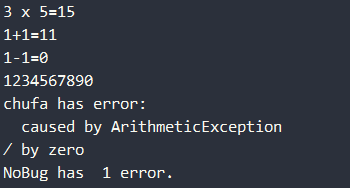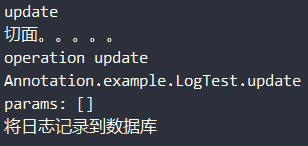JAVA基础:注解应用示例
本文需要的背景知识:JAVA基础:注解机制
1 利用反射,构建框架
—— 程序员 A : 我写了一个类,它的名字叫做 NoBug,因为它所有的方法都没有错误。
—— 我:自信是好事,不过为了防止意外,让我测试一下如何?
—— 程序员 A: 怎么测试?
—— 我:把你写的代码的方法都加上 @Check 这个注解就好了。
—— 程序员 A: 好的
-
编写注解
@Retention(RetentionPolicy.RUNTIME) public @interface Check { } -
实现NoBug类
public class NoBug { @Check public void suanShu(){ System.out.println("1234567890"); } @Check public void jiafa(){ System.out.println("1+1="+1+1); } @Check public void jiefa(){ System.out.println("1-1="+(1-1)); } @Check public void chengfa(){ System.out.println("3 x 5="+ 3*5); } @Check public void chufa(){ System.out.println("6 / 0="+ 6 / 0); } public void ziwojieshao(){ System.out.println("我写的程序没有 bug!"); } } -
编写Test类进行检查
public class TestTool { public static void main(String[] args) { // TODO Auto-generated method stub NoBug testobj = new NoBug(); Class clazz = testobj.getClass(); Method[] method = clazz.getDeclaredMethods(); //用来记录测试产生的 log 信息 StringBuilder log = new StringBuilder(); // 记录异常的次数 int errornum = 0; for ( Method m: method ) { // 只有被 @Check 标注过的方法才进行测试 if ( m.isAnnotationPresent( Check.class )) { try { m.setAccessible(true); m.invoke(testobj, null); } catch (Exception e) { // TODO Auto-generated catch block //e.printStackTrace(); errornum++; log.append(m.getName()); log.append(" "); log.append("has error:"); log.append(" caused by "); //记录测试过程中,发生的异常的名称 log.append(e.getCause().getClass().getSimpleName()); log.append(" "); //记录测试过程中,发生的异常的具体信息 log.append(e.getCause().getMessage()); log.append(" "); } } } log.append(clazz.getSimpleName()); log.append(" has "); log.append(errornum); log.append(" error."); // 生成测试报告 System.out.println(log.toString()); } }
输出结果为

参考:https://blog.csdn.net/walk_man_3/article/details/79480326
2 AOP日志
2.1 MyLog注解
@Target(ElementType.METHOD) //注解放置的目标位置,METHOD是可注解在方法级别上
@Retention(RetentionPolicy.RUNTIME) //注解在哪个阶段执行
@Documented //生成文档
public @interface MyLog {
String value() default "";
}
2.2 切面配置类
@Aspect
@Component
public class LogAspect {
/**
* 配置织入点 - 自定义注解的包路径
*
*/
@Pointcut("@annotation(Annotation.example.MyLog)")
public void logPointCut() {
}
/**
* 处理完请求后执行
*
* @param joinPoint 切点
*/
@AfterReturning(pointcut = "logPointCut()", returning = "jsonResult")
public void doAfterReturning(JoinPoint joinPoint, Object jsonResult) {
System.out.println("切面。。。。。");
//保存日志
//从切面织入点处通过反射机制获取织入点处的方法
MethodSignature signature = (MethodSignature) joinPoint.getSignature();
//获取切入点所在的方法
Method method = signature.getMethod();
//获取操作
MyLog myLog = method.getAnnotation(MyLog.class);
if (myLog != null) {
String value = myLog.value();
System.out.println("operation "+value);
}
//获取请求的类名
String className = joinPoint.getTarget().getClass().getName();
//获取请求的方法名
String methodName = method.getName();
System.out.println(className + "." + methodName);
//请求的参数
Object[] args = joinPoint.getArgs();
//将参数所在的数组转换成json
String params = JSON.toJSONString(args);
System.out.println("params: "+params);
System.out.println("将日志记录到数据库");
}
/**
* 拦截异常操作
*
* @param joinPoint 切点
* @param e 异常
*/
@AfterThrowing(value = "logPointCut()", throwing = "e")
public void doAfterThrowing(JoinPoint joinPoint, Exception e) {
System.out.println("exception");
}
}
2.3 测试类
@RestController
public class LogTest {
@MyLog("update")
@PostMapping("/test")
public void update(){
System.out.println("update");
}
}
2.4 测试
启动服务,使用postman模拟一个请求,可以观察到

通过这种方法,就可以很好地进行日志记录了
2.5 附:maven文件
<?xml version="1.0" encoding="UTF-8"?>
<project xmlns="http://maven.apache.org/POM/4.0.0"
xmlns:xsi="http://www.w3.org/2001/XMLSchema-instance"
xsi:schemaLocation="http://maven.apache.org/POM/4.0.0 http://maven.apache.org/xsd/maven-4.0.0.xsd">
<modelVersion>4.0.0</modelVersion>
<groupId>com.cpaulyz</groupId>
<parent>
<groupId>org.springframework.boot</groupId>
<artifactId>spring-boot-starter-parent</artifactId>
<version>2.1.3.RELEASE</version>
<relativePath/> <!-- lookup parent from repository -->
</parent>
<artifactId>com.cpaulyz</artifactId>
<version>1.0-SNAPSHOT</version>
<dependencies>
<dependency>
<groupId>org.mockito</groupId>
<artifactId>mockito-core</artifactId>
<version>2.23.4</version>
<scope>test</scope>
</dependency>
<dependency>
<groupId>org.springframework.boot</groupId>
<artifactId>spring-boot-starter-aop</artifactId>
</dependency>
<dependency>
<groupId>org.springframework.boot</groupId>
<artifactId>spring-boot-starter</artifactId>
</dependency>
<dependency>
<groupId>org.springframework.boot</groupId>
<artifactId>spring-boot-starter-web</artifactId>
</dependency>
<dependency>
<groupId>org.springframework.boot</groupId>
<artifactId>spring-boot-starter-thymeleaf</artifactId>
</dependency>
<dependency>
<groupId>net.sourceforge.nekohtml</groupId>
<artifactId>nekohtml</artifactId>
<version>1.9.18</version>
</dependency>
<dependency>
<groupId>org.springframework.boot</groupId>
<artifactId>spring-boot-devtools</artifactId>
<scope>runtime</scope>
</dependency>
<dependency>
<groupId>org.springframework.boot</groupId>
<artifactId>spring-boot-starter-test</artifactId>
<scope>test</scope>
</dependency>
<dependency>
<groupId>com.alibaba</groupId>
<artifactId>fastjson</artifactId>
<version>1.2.62</version>
</dependency>
</dependencies>
<build>
<plugins>
<plugin>
<groupId>org.springframework.boot</groupId>
<artifactId>spring-boot-maven-plugin</artifactId>
</plugin>
</plugins>
</build>
</project>
参考
https://www.pdai.tech/md/java/basic/java-basic-x-annotation.html